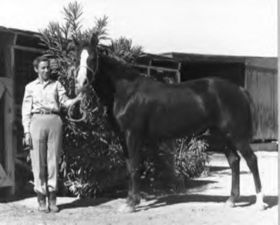Translation of the hujjah of Saud desert-bred import *Halwaaji
In the name of God the Most Merciful and Compassionate
City of Riyadh
Region of Najd
Kingdom of Saudi Arabia
11 Rabi’ the second 1378 corresponding to 25 October 1958
I, Mutlaq al-‘Atawi, supervisor of the royal horse stables of his Highness King Saud ibn ‘Abd al-‘Aziz, declare that the following testimony is correct:
The filly “Halwaaji”, characterized by the following:
The color of her body is red [“ahmar”], and her tail and mane are “red”, she has a big white blaze on her forehead, her upper and lower lips are white on their right side, and dark on their left side, she has a bunch of white hair on her neck, under the left side of her mane more specifically, she has an irregular string of white hair on the back side of her neck, her left hind left leg has a white stocking with a white hoof; as to her other hoofs they are dark, and on her left upper hind leg she has three white spots of white hair; she also has a three small white dots on her upper front legs;
She was born in the stables of his Majesty’s horses in Khafs Daghrah in the area of Najd on the date of Rajab the thirteeth 1373 corresponding to March the 18th 1954. As to her dam, she is the filly “Eedah” and her sire is “Sari”, and both are wholly Hamdani and from a noble origin. And I certify in the face of God may he be awed and respected that the mare “Halwaaji”
is whole-in-the-strain from a noble origin, tracing to horses whose purity of blood and lineage have been preserved by the Saud family.
Mutlaq al-‘Atawi
[Signature]
Testified about him [i.e., about Mutlaq]
Muhammad Ibrahim al-Khudayr
The secretary
Notes from Translator Edouard Al Dahdah:
Even if the text uses “ahmar” it is clear from the color of the mane and tail that the mare is chestnut.
The document uses “khalis”, which means “entire” or “whole”; it occurs twice in the hujjah in slightly different grammatical forms: in both cases, it means the mare is entirely Hamdani, and can also be translated by “pure-in-the-strain”. I refrained from using the word “pure”, because ‘khalis’ does not have the connotation of purity, but the meaning is the same.

I translated this in 2007 for the AKA3. This is a mare from the homegrown strain of the Saud family.
Mutlaq al-‘Atawi and his brother Mish’al are both Ateybah Bedouins who were in charge of the King’s stud.
I have just realised why Halwaaji’s name sounded familiar – she’s the tail female for a mare I really like, Aelfleah Hadhafang, who had an active showing career as a jumper and an eventer.
Dear Kate: Yeah Aelfleah had one foal by a Warmblood stallion which is listed as a German sport horse/ pony. That seems to be the pattern for producing kids competition horse in Europe a Warmblood mixed with an Arab. I’m curious if they lose the leg bone when making the f1 cross which had always been the stated rationale for using Shagyas rather than purebreds…
best
Bruce Peek
Bruce, yep, a colt by Nassau. He seems to have decent bone in his legs. Hadha also has a 2019 Blue Star colt, Aelfleah Samwise, by Samrah Hamdani Simri. Aelfleah Farm has a Blue Star half sister to Hadha, Aelfleah Lazawrd, by AAS Aswad Walida, and a GRP half sister, Aelfleah Falchion, by a Welsh Cob stallion.
How common are the Blue Stars these days? Are they a fairly numerous breeding group, or are they getting close to a code red status?
best
Bruce Peek
it’s a fast dwindling group.. very fast.
All breeding groups in the Al Khamsa, Inc. tent except the straight Egyptians are in the endangered category, and there are some bloodlines in the SE that are being lost as well. It’s not a good situation.
Bruce, all lines considered “Blue Star,” are at least Al Khamsa Code Orange status, except *Fadl, *Turfa and Sirecho.
At the time this document was written, how long had Saud had this Hamdani strain and where did they get it from?